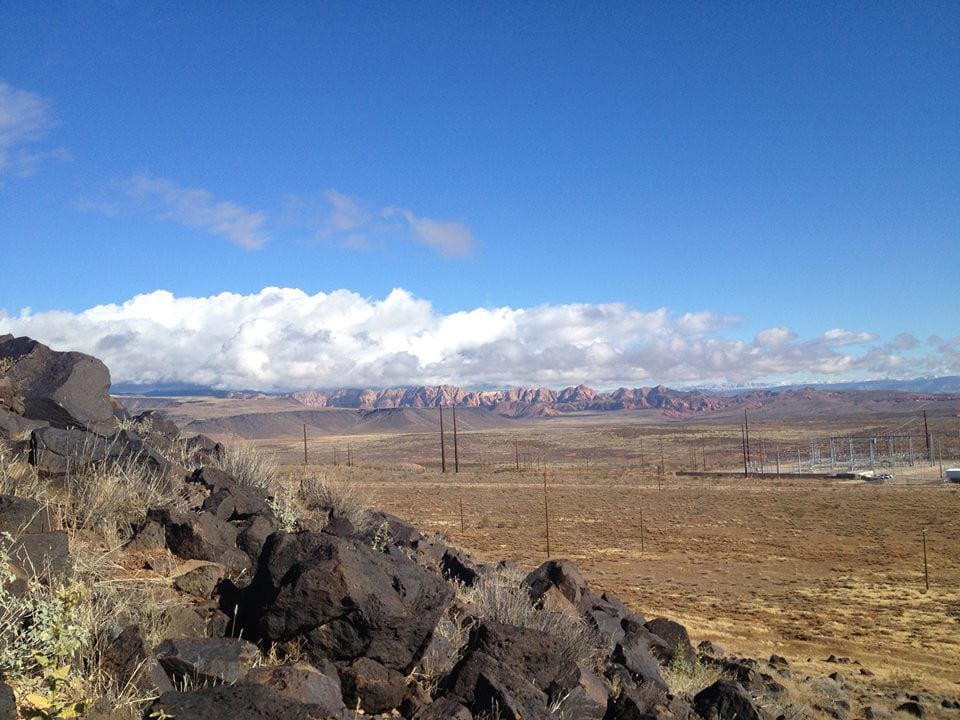 Twenty years from now, the quiet desert north of St. George might look very different. There might be a four-lane highway winding its way past red cliffs and black mesas, whisking cars at high speeds from Washington City to where Red Hills Parkway intersects with UT18. If the plan that the Washington County Commissioners and The Dixie Metropolitan Planning Organization (along with many others within the various municipalities of the county) comes to fruition, that quiet desert will be much less quiet. Travelers will be able to pass the congested intersections of Green Springs and St. George Boulevards and reach the cities of Ivins and Santa Clara much more quickly.
Twenty years from now, the quiet desert north of St. George might look very different. There might be a four-lane highway winding its way past red cliffs and black mesas, whisking cars at high speeds from Washington City to where Red Hills Parkway intersects with UT18. If the plan that the Washington County Commissioners and The Dixie Metropolitan Planning Organization (along with many others within the various municipalities of the county) comes to fruition, that quiet desert will be much less quiet. Travelers will be able to pass the congested intersections of Green Springs and St. George Boulevards and reach the cities of Ivins and Santa Clara much more quickly.
However, is it the right plan? Will the Northern Corridor actually alleviate the traffic that the Dixie Metropolitan Planning Organization anticipates? How will having this large gap in the National Conservation Area affect the Mojave desert tortoise? Are there better options?
These questions were posed to Lisa Rutherford and Paul Van Dam, who have been fighting against the proposals to build the Washington Parkway for years. They took the time to compose formal responses to each of these questions. Their opponents who wish to see the Washington Parkway constructed will likewise have the opportunity to answer the same questions next week.
Is the proposed Northern Corridor the right plan?
“This is not the right plan to meet our needs in Washington County. The 2009 Omnibus bill that directed the BLM’s current [Resource Management Plan] clearly states that the [National Conservation Area] was established to protect each species that is located in the NCA and listed as a threatened or endangered species. Although discussions may have been had prior to the bill’s passage that counter this position, the bill is clear that the BLM can offer options for a road and not necessarily accept the plan preferred by our county commissioners and Senator Hatch. UDOT’s Red Hills Parkway 2007 Environmental Assessment and Draft Section 4(f) Evaluation references ‘Alternatives Considered but Eliminated from Further Consideration,’ which includes the Northern Corridor. It notes that the Northern Corridor Alternative would not meet the objective of minimizing impacts to the Reserve and also notes that, a [U.S. Fish and Wildlife Service] letter states ‘such a road would compromise the commitments on which the Washington County [Habitat Conservation Plan] was based, is likely to compromise the biological integrity of the Upper Virgin Recovery Unity (already the smallest recovery unit), and may result in an adverse modification of designated critical habitat.’ Due to this and other issues raised in the report, ‘The City of St. George, UDOT, and [Federal Highway Administration] determined that the anticipated implementation challenges and potential environmental effects, as previously described, would be substantial and thereby eliminated the Northern Corridor Alternative from further consideration.’ The assessment also notes that the road has the ‘potential to jeopardize the status of the countrywide incidental take permit, which could have major economic impacts…’
“In 2012, UDOT came out with a second report that attempted to prove that the road would actually help the tortoise by allowing access to areas of the Reserve/NCA through culverts for mating purposes. Whether this sufficiently gives the tortoise enough help to counter all the other negatives associated with the road remains to be seen.
“If the law clearly mandated the Northern Corridor be built, Senator Hatch would not now have submitted an amendment to make the law do what the county commissioners and others think it should. Rather, the BLM was given direction to identify one or more alternatives for a northern transportation route in the county, and that’s what they have done.”
Will the Northern Corridor alleviate the traffic that the Dixie Metropolitan Planning Organization anticipates?
“The 2011 Washington Parkway Cost/Benefit Study by Horrocks Engineering for Dixie MPO reviewed six road options. Neither Option 3, which is the preferred route by the commissioners and Senator Hatch, nor any of the other five options ‘…reduced traffic on Bluff St., St. George Blvd. and Red Cliffs Dr. to the point that congestion on these corridors was eliminated.’ However, Option 3 did seem to provide a more manageable situation. Is spending $100 million dollars on a road that will only provide a ‘more manageable’ situation good use of taxpayer money?”
How will having this large gap in the National Conservation Area affect the Mojave desert tortoise?
“Already the effects of Washington County’s growth are increasing human impacts on the Reserve/NCA as noted in many [Habitat Conservation Advisory Committee] meetings. A road, with all the initial construction activities and vehicular traffic, once it’s built, will bring additional human impacts to the area. The traffic noise, auto emissions and fire potential are just some concerns. The HCAC’s Technical Advisory Committee will be required to maintain additional fencing along the new highway and probably deal with social trails that will result from additional access to the Reserve/NCA. The property taken to build this road cannot be “mitigated” as required by the [Habitat Conservation Plan]. Suitable habitat to serve as mitigation is not sufficient, if available at all.”
Are there better options?
“Red Hills Parkway is already there and will be viable for a long time. Projections may show that it will be overwhelmed with traffic, but with growth shown to focus on the southern and southeastern part of this county, it remains to be seen if or how this traffic will materialize. Add to that the fact that we have not seen the impacts of all the other road work that has been done to see if that work will help with some of these projections and relieve traffic congestion. Red Hills Parkway may be expanded, and that would take less land than the proposed Northern Corridor. The Dixie MPO’s own recently released draft transportation report make it clear that roads will not solve our transportation problems. This contentious road will not prevent traffic congestion but will cost, according to Phase Two and Phase Three planning projections, nearly $100 million dollars of our precious tax dollars, not including costs of litigation that will surely follow.”
The fight over the Northern Corridor is a complicated, contentious issue, with no easy answers regardless of how each side frames their arguments. Growth will continue to occur in Washington County at a pace that will have negative impacts for the environment despite mitigation efforts. Both sides of the issue are genuine in their beliefs that the Northern Corridor should or should not be built. Many battles remain to be fought in this war.
Be sure to stay tuned next week for the fourth part in this series: The builders response.
RELATED STORIES:
– The Ghost Highway: The battle for the Northern Corridor, part I (an introduction)
– The Ghost Highway: The battle for the Northern Corridor, part II (the builders)



